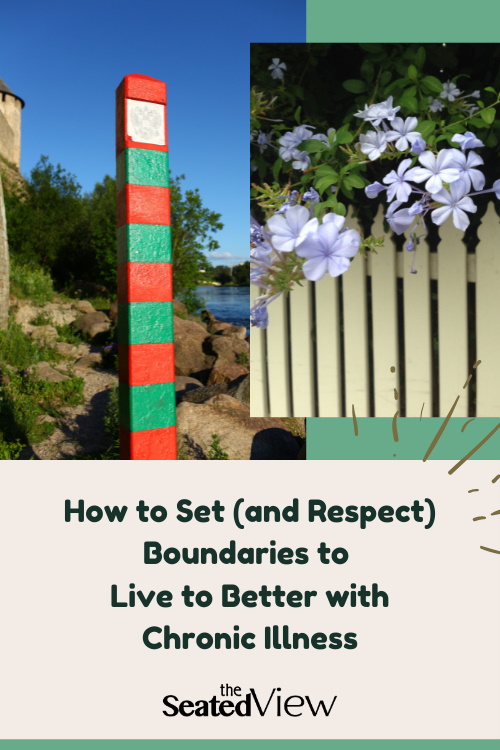How to Set (and Respect) Boundaries Live to Better with Chronic Illness

Boundaries can be an important part of mental health and when you have a chronic illness, they are an essential tool to maintain your physical health. But what are boundaries, exactly, and how can they help you create a better life with chronic illness and pain? In this post, I share some of my insights and experiences, as well as some tips to get started
Watch my Facebook Live on setting boundaries.
What are boundaries
Boundaries are limits we set in our relationships and our lives. When you live with chronic illness, they are an important part of self-care, of learning to protect yourself and your health, and of creating equal and respectful relationships. And they can be really difficult for those of us with chronic illness who might feel constantly guilty about all the things we can no longer do in general, and for others specifically.
There are many types of boundaries that you may want to consider in your life. For instance, your chronic illness may give you some physical boundaries around what you can and cannot do. Emotional boundaries can protect you against the anger of others or help you remember that strangers are not entitled to your medical history. Work boundaries can help you create a better work-life balance.
Creating a healthy set of boundaries includes the following three steps. For many years, I’ve had to take a daily nap to manage my pain and energy levels and I’ll use it as an example in each step.
- Step 1: Set a boundary. I recognized that I needed to lie down and sleep every day because otherwise the levels of my pain and fatigue would destroy my quality of life.
- Step 2: Protect the boundary. I treat my nap as sacred, making no exceptions. I am simply not available in the late afternoon.
- Step 3: Help others understand the boundary. I remained my daily nap to the Mandatory Rest Period. This helped others understand that this was a necessity, not an indulgence, and that it was an immovable part of my life
These three steps can lead you to recognizing that you need and have boundaries, help you protect them by being aware of what’s negotiable and in which situations, and help others understand that there is a boundary that you will not let them cross. Let’s dive into some details.

How do you know you need a boundary?
The idea of boundaries and how to keep them are becoming more of a frequent conversation. For instance, parents of young children are teaching their kids that they don’t have to hug anyone if they don’t want to, which is an excellent way to teach your children about emotional and physical boundaries. As well, there are conversations about asking for consent before having a vent about problems with a friend to make sure they have the emotional bandwidth to listen. This is a good way to be conscious about the fact that people have limits and boundaries and a right to say, “I love you, but not today.”
For those of us who did not learn about boundaries as children, it can be difficult to identify when yours are wobbly. Some of the signs that you might need to shore up a boundary include burnout, feeling pressure to do something that you don’t want to do (or don’t feel able to do), and feeling exploited or bullied. But with chronic illness there are also other signs of shaky boundaries. For instance, overdoing it to the point of flaring, not feeling heard in a doctor’s appointment, feeling exhausted after work or an event, or feeling guilty if you need to cancel plans because of your chronic illness.
So how do you begin to build boundaries? It starts with the why.
Start with WHY to create strong boundaries
Other people will respect your boundaries if you yourself respect your boundaries. That means standing firm when people try to push past one of your boundaries — and people will try. But they will learn to stop pushing if you show them that this is non-negotiable.
Being conscious of why you created a particular boundary can help you not give in to the inevitable attempts to cross it. Here’s here are some examples of the Why behind different boundaries:
- Health boundary. My nap as an example of a boundary that protects my health. Boundaries in this category help you have more joy in your life, more ability to do the things you want to do, and more energy to give of yourself.
- Emotional boundary. Protects your mental health, helps you be happier and stops other people from taking advantage of you.
- Work boundary. Helps you do you work faster with higher quality and without getting burned out.

Respecting your own boundaries
if you’ve had wobbly — or nonexistent — boundaries for a long time, it can be difficult, even kind of scary, to start getting about firm about them. Likewise, if you’ve been a people pleaser all your life, protecting a boundary can feel like maybe people won’t love you anymore. Trust me: the people who do love you will get it.
If you remember only one thing from this post, it’s this: if you don’t respect your own boundaries, no one else will. Needing to take a nap every day was a very valuable lessons that I set the tone. We tell people how they can treat us and what we are able to do. When you know the Why behind your boundary, it will be much easier to draw that line.
It can also be helpful to have a clear idea of responsibility and level of urgency. For instance, if someone asks you to do something, think about whether it is your responsibility to fix the problem or deal with the issue. A wonderful Polish saying can be a help in situations like this: “not my circus, not my monkeys.
It can also be useful to do a mental check-in, asking yourself if you are the best person for the task. That check can include questions like whether you are the appropriate person to deal with this — perhaps it’s actually someone else’s job — and rather you have the time and space to do it. Because if you don’t have the time or the energy, you can’t do the task well and therefore you are not the best person for it. This is when I also like to remember the saying attributed at various times to Bob Carter, Tim Ferries and Garfield the cat: “failure to plan on your part does not constitute an emergency on my part.”
We all have boundaries in our lives, but very few of us have learned to recognize when we need them and what they should be. Start by doing some thinking about situations that make you feel uncomfortable and try to find out why — chances are it may include someone walking past a boundary. Likewise, thinking about moments when you have felt safe and free to be vulnerable can also help you realize what happens when your boundaries are respected. It’s a good start to figuring out what you need, why you need it, and how to creat boundaries that can support your life with chronic illness.
Tag: balance, boundaries, chronic illness, mental health, relationships, rheumatoid arthritis, rheumatoid disease
Read More
Discover what else I've been writing about...















